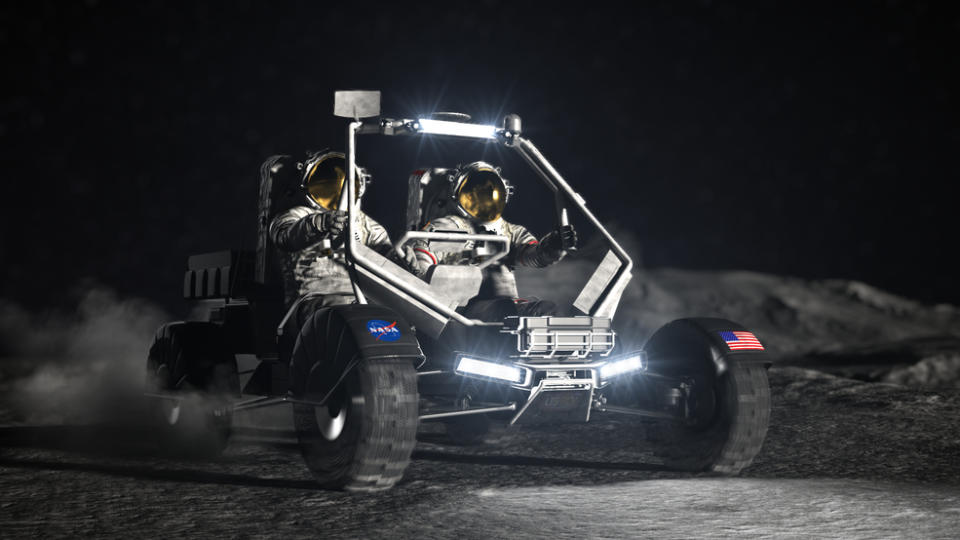This MU math professor has a hand in training for the next-generation lunar rover
In the early 1970s, astronauts drove a lunar rover — a dune buggy, of sorts — bouncing around on the moon on short treks.
It holds an interest for Stephen Montgomery-Smith, a math professor at the University of Missouri.
"Driving on the moon, if you drive at a fairly slow speed, you look at the Apollo program from the '70s and they're going 5 mph tops," said Montgomery-Smith. "And when they're doing 5 mph, they're bouncing all over the place. Part of it is that the moon is very rocky and then part of it is because the gravity is weaker. You don't have the same grip of the wheel on the ground."

It was a risky situation, he said.
"When they put that rover up there, they had no idea it would work," Montgomery-Smith said of the Apollo missions.
Montgomery-Smith considered these aspects as he helped develop a simulation for NASA's future Lunar Terrain Vehicle.
NASA plans to use the vehicle for crewed operations starting in 2029 with the Artemis V mission. Before astronauts arrive, though, it will be used for un-crewed and commercial activities after it lands on the moon, according to a May 26 NASA news release.
It will function like a cross between the Apollo lunar rover and a Mars-style autonomous rover, according to NASA.
"Things happen in outer space a lot different than on Earth," Mongtomery-Smith said.
The simulator he helped develop converts the feeling of a vehicle moving to a "table," the platform on which a test subject is seated, he said.
"I've got to convert that vehicle moving to a table moving," Montgomery-Smith said. "So the person riding on the table feels like he's driving on the moon."
He used two skills to accomplish it.
"You have to know mathematics and you also have to know how to program computers," he said. "And actually, that's a rare combination."
Many people know how to program, or do complex math, but it's not common to do both, he said.

He got hired at MU in 1989 after arriving in 1988 as a visiting professor. At the time, universities were experiencing a shortage of math professors, he said.
In his career here, he has co-authored a few papers with Nobel Prize-winner George Smith, professor emeritus in chemistry, he said. He was able to add math calculations to Smith's chemistry research.
The simulator also features virtual reality goggles for the person testing it.
The astronauts will be on the south pole of the moon, where the sun is very low in the sky.
"There's no atmosphere, so it's like full, bright sunlight" at sunset, he said.
In one direction, Astronauts are driving directly into the sun, despite having a heavily shielded visor. In the other direction are very long, black shadows.
The simulator is called the Systems Engineering Simulator. Montgomery-Smith's software drives its motion base, said Tim Hall, SES manager, in an email.
It's the best option since there's no moon surface on earth on which to test a vehicle, he wrote.
"We understand that motion base driving simulators are common and useful for training and systems engineering for vehicles here on earth where simulators have been compared to field testing of vehicles," Hall wrote. "With the work conducted to this point we expect it could be useful for driver familiarization in the complex lighting environment of the south pole. It could also be useful for evaluation of human factors of the rover design.”
It's not the only work Montgomery-Smith does for NASA. He also helps with software to develop space docking systems. That will be used with the Gateway station that will permanently orbit the moon.
He was introduced to NASA by a former student, Cecil Shy, who works at NASA.
"He's the reason I got the jobs," Montgomery-Smith said of his former student.
Montgomery-Smith's work on the Lunar Terrain Vehicle also informed the requests for proposals sent to companies. NASA will contract with one of the companies to build it. The proposals were due in July and a contract will be awarded as scheduled next month.
NASA's VIPER autonomous rover is scheduled to start exploring the moon's south pole in late 2024.
Others also are working on moon vehicles, including one being developed by Toyota and the Japan space agency.
In a few years, Montgomery-Smith said he will enjoy seeing astronauts on the moon riding a vehicle he helped develop.
"I feel good about that," Montgomery-Smith said of his role.
He joked about the possibility of an MU bumper sticker on the back of the LTV.
Roger McKinney is the Tribune's education reporter. You can reach him at rmckinney@columbiatribune.com or 573-815-1719. He's on X at @rmckinney9.
This article originally appeared on Columbia Daily Tribune: MU math professor helped develop Lunar Terrain Vehicle simulator

